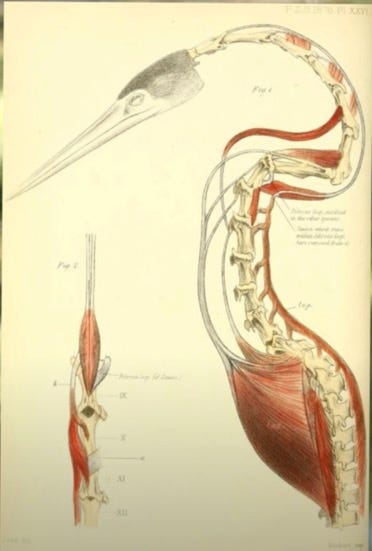If you live on this planet, and especially in North America, city or wilderness, you have seen herons. You’ve seen lots of herons all over the country as you visit lakes, ponds, wetlands, ocean shorelines, and bays. They are such a striking silhouette, whether in flight or standing, that many people remark that this must be the Pterodactyl hold-over from the dinosaurs. Let’s step back a little though and take a look at the Great Blue Heron that visits the ponds of the Foothills here, now.
Long, thin legs wade through the water, with, long claws and keen eyes, searching for fish, frogs, salamanders, small turtles, voles, crayfish, grasshoppers, varmints, and dragonflies. You get it, about anything it can catch and shove down that long neck. Eleven pounds of food a day, swallowed whole, in their 4-8 pound bodies. Their bill is long and razor-sharp to impale the prey. The S-curve of their neck sways and strikes like a snake. Twenty vertebrae make up that long neck, allowing it to move in any direction with killing force. Twenty vertebrae? How does that compare with your neck? Well, you have seven vertebrae and a range of about 60 whole degrees. Your dog is the same. Mr. Heron (I’m using that generically as the males and females are not easily distinguishable) would not want to trade with you, and his neck folds up nicely for travel.
That long neck can have a disadvantage for Mr. Heron when he tries to tackle some prey too large. Herons have been known to choke to death on their impulsive meals. One heron tried to take on a lamprey eel. It didn’t end well. The wise herons can live up to 15 years as they are rarely the prey of other animals.
The other thing that you might notice in a closer look at the heron is the long, stringy feathers on its chest, unlike other birds you see.


Mr. Heron is very proud of his plumage and while it makes a lovely courtship display, it has a very practical purpose as well. These feathers are called ‘powder down’. A number of birds do have powder down patches, but Mr. Heron’s are most noticeable. These long feathers, that grow continually (not molted), get combed by the heron’s fringed middle claw, and break down to a powder that is then distributed to the other feathers when preening. This powder causes pond scum and fish slime to clump up and is then easily preened off. Mr. Heron always tries to be on his best appearance, he does bear some snappy colors for the ladies.

So, surely, that long neck and long legs trailing in flight make you think you are suddenly watching Jurassic Park, right? And you are partially correct, but the story is even more interesting. These adaptations and a highly varied diet have made herons some of the most successful species on the planet. The fossil records show that they have been around for over 15 million years. But, related to the pterodactyl? Nope, they are more related to the T-rex! It’s amazing how much I found on the evolution of this goofy-looking bird, it seems to have captured many people’s curiosity to study it. Take the T-rex, elongate its legs, slim the body, and turn those silly arms into 6-foot long wings. You’ve got tens of millions of years to get there. You can follow some of the links in the sources section to get a more in-depth discussion of it.
Suffice it to say, that the Great Blue Heron is truly one of the world’s most successful species, adapting from oceans to high elevations, hot and cool climates, tidal flats to deep lakes, and every pond and wetland in between. A diet from fish to frogs to voles and even squirrels means it can eat almost anywhere. They’ve even been known to try out the human tidbits like the crows do. Its most difficult challenge was with mankind though. The demand for heron feathers on women’s hats in the 1800’s caused numbers to decline considerably. Thankfully, in the Twentieth Century, that was outlawed and populations have rebalanced.
Where does the heron reside ecologically? Right with all the other predatory species. Keeping populations of fish, amphibious creatures, and even rodents in check. Thank Mr. Heron for snacking on that vole next time you see him. And if he gives you pause, a moment to look up, watch him fly, and then look back on your to-do lists and busy day with some new perspective, you can thank him again. My, doesn’t he look fine….
Sources:
- https://en.wikipedia.org/wiki/Great_blue_heron
- https://www.allaboutbirds.org/guide/Great_Blue_Heron/overview
- https://www.audubon.org/field-guide/bird/great-blue-heron
- https://www.birdnote.org/listen/shows/powder-down
- https://blogs.scientificamerican.com/tetrapod-zoology/ode-to-the-great-blue-heron/
- http://willoughbyart.blogspot.com/2012/07/the-neck-is-lie.html






